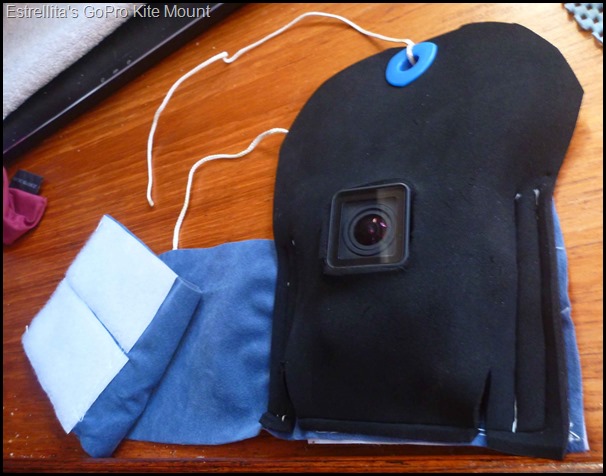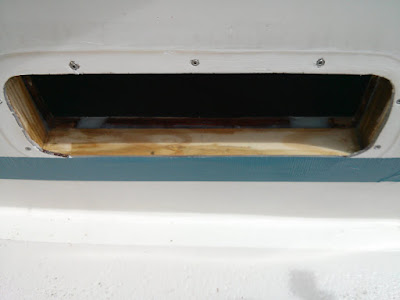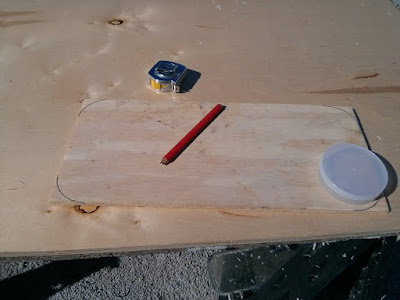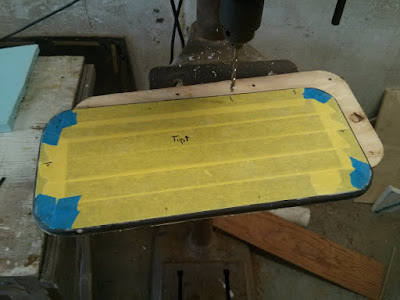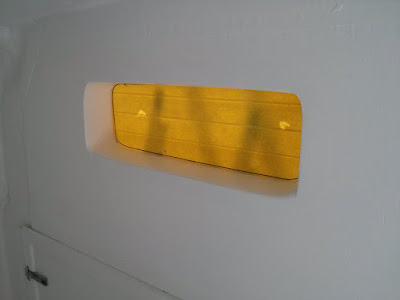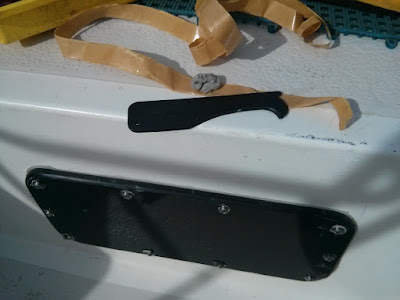There are many ways to strap a GoPro on when kiting. You can mount it on your kiteboard, your helmet, your kite strings, or even (*groan*) a selfie stick.
We like the shots we get with our GoPro strapped to the main strut of our kite, near the leading edge and this is the mount I made to do so. I made wide strap out of Crypton Ultrasuede scraps I had aboard from our cushion covers with two strips of 2” velcro. I used some Seam Stick at first so I could take it to the beach and fit it onto a few different size kites to make sure it would work before I sewed it.
Then I took neoprene from an old old laptop case and made a pocket for the GoPro. In the flap on the open side of the pocket, I put a snap in plastic tarp grommet and some kite string (spectra type). The kite string was cut long enough so that one side could be tied to the pump up loop on the kite and the other side to the GoPro in case the case failed.
With the case and camera mounted on the kite, I outlined the lens of the GoPro with chalk, removed the case, and cut out the lens hole.
We accidentally tested the backup string when we crashed the kite so hard that the camera popped out through the lens hole (!!!) and the string kept the GoPro dangling from the kite while we sailed back to the beach and removed it.
And here is what we get with it. Not as flexible as a drone, but dirt cheap, and very satisfying.
Wednesday, December 23, 2015
Kite Mount for GoPro
Livia and Carol, living and cruising aboard s/v Estrellita 5.10b have been kiting their way thru paradise. But how do you proove that to others? You need a kite mount for your GoPro camera...
Labels:
kites,
photography,
s/v Estrellita 5.10b
Wednesday, December 16, 2015
Replacing the Leaking Quarterberth Port
Jeff and Anne continue their refit of s/v Pilgrim. Today we follow along with them as they replace a leaking port, a project many of us could have to face. The unusual part of the project is the thickness of the hull at the port location.
Jeff made this as three posts; I have condensed them into one.
Jeff made this as three posts; I have condensed them into one.
While sanding in the engine compartment, a passing a rain shower alerted me to how badly the old, plastic quarterberth port was leaking. All the other ports in the Pilgrim are New Found Metal Stainless Steel ports, installed by a previous owner. Replacing the only remaining original plastic port was on the project list. Watching row of steady drips along the starboard side wall of the engine compartment elevated the project priority.
We believe the plastic port in the quarterberth was installed at the factory in 1979.
Frequently after rains I check the quarterberth area for water intrusion. Never found any signs the port was leaking. It never occurred to me to check the engine compartment. The leak originated around the outer flange of the port. The water then dripped down thru the void between the fiberglass wall of the cockpit foot well and the ¾” plywood cabinetry wall of the quaterberth.
The original port, set in copious amounts of silicone sealant, heartily resisted removal. Ultimately the combination of a razor knife and pry bar won the day.
The exterior view of the hole remaining after the port was removed.
After sanding down the surrounding surfaces, I filled the nearly 1-1/2” wide void around the perimeter of the opening with trimmed down pieces of a pressure treated 2” X 4”.
Fitting treated wood plugs into the void around the perimeter of the opening.
The wood plugs fit snuggly. Once in place, I mechanically fastened the wood filler to both the outer fiberglass and the interior plywood using flat head stainless steel screws.
Filling gaps and irregularities around the opening with thickened epoxy.
Next, the remaining gaps and irregular surfaces were filled with cabosil thickened epoxy. After sanding down the initial round of epoxy filler, the fairing began.
Round one of fairing viewed from the interior.
Fairing required two rounds of epoxy thickened with a micro-balloon filler (q-cells). Each round of filler was followed by additional sanding.
Two rounds of fairing completed. Now ready for primer.
The interior surfaces were finished with two coats of latex primer and two coats of exterior grade latex paint.
The interior completed. Test fitting the masked acrylic window pane.
Since we intend to use Pilgrim’s quarterberth as a storage area only, we chose to install an acrylic window pane rather than a new opening port. We realize not installing an opening port will reduce ventilation in the area. We have scrap pieces of tinted acrylic on hand. New ports are very expensive. Using the acrylic will save us money. The window will provide natural lighting for the storage area.
View from the interior with the new window installed.
See our Quarterberth Refit Photo Album for images and notes current progress on this project.
Next up, the outside story… fabricating and installing the new acrylic window pane.
Our previous post, Replacing the Leaking Quarterberth Port, the Interior Story, explains why, and how we removed the original port. The post also shares our reasoning for replacing the port with fixed pane window.
As many boat projects are apt to do, the exterior story begins with… creating a template.
Creating a 1/4" plywood template of the window pane. Yes, that is an electrical tape canister we are using for the corner radius.
The template will allow us to “test” the aesthetics of the panel prior to cutting into our limited supply of acrylic material. The template will also serve as a guide for the router bit used to trim the acrylic. ½” plywood was my preferred template material. Unable to find an appropriate piece of scrap we used ¼” plywood.
Pleased with the look and fit of the template, we then transferred the shape to the masked acrylic.
Template dimensions transferred to the masked acrylic sheet.
Ok, time for a disclaimer… our experience working with acrylic, Lexan, Plexiglass, and similar materials is very limited. We welcome any comments or suggestion on working with these types of materials.
The material we are using is ½” thick Chemcast Cell Cast Acrylic Sheet. We reclaimed the scrap material from a project on another vessel. Since the material was previously installed it lacked the protective coating found on virgin material. When possible we kept the pane masked with painters tape during the install process.
Prior to cutting the actual pane, I experimented with various cutting tools and techniques. The jigsaw with Plexiglas specific blades generated too much heat. The heat melted the acrylic and created a rough, scored edge. Perhaps the jigsaw blades would work better on thinner material? Using the hand held circular saw with a multi-purpose blades (24 to 40 teeth) yielded similar results to the jigsaw. The best solution I found was to use a fine crosscut blade (90 teeth) in the circular saw to rough cut the acrylic. Then use a router with a flush trim bit for the final shaping.
With the template as a guide, I used a router with a flush trim bit to clean up the edges of the acrylic window pane.
I clamped the rough cut pane atop the plywood template. The template then served as a guide for the flush trim router bit. Since the guide wheel on the router bit transfers any irregularities from the template to the finish material it is important to sand down the rough edges of the template. Yeah, I learned this the hard way.
Unfortunately the painters tape masking did not play nice with the router. My solution…
Masking the base of the router proved more effective than masking the acrylic face.
Remove the masking from the acrylic and place a couple strips of masking on the base of the router. Masking the base of the router worked for both the flush trim bit and the round over bit used to radius the outside edge of the pane.
Next the edges of the acrylic were sanded beginning with 220 grit and progressing up to 600 grit sandpaper. Sanding the edges up to 600 grit brought them back to a dull, smooth surface. I certain by a polished edge could be achieved if so desired.
Part 1 of the Exterior Story focused on shaping the window pane (Link: Replacing the Leaking Quarterberth Port, the Exterior Story – Part 1.) Thanks to everyone the left suggestions and links on the last post. Now we are on to installing the window.
Drilling over-sized holes for fasteners in the acrylic window pane.
Due to thermal expansion / contraction the pilot holes for mechanical fasteners need to be over sized. I also drilled a slight counter sink on the exterior pilot holes to provide space for butyl tape bedding. This work was all done on a drill press.
Clamping window in place to test fit, mark fastener locations, and scribe window opening on interior face.
The window moved from the drill press to a test fit on Pilgrim. While the window was clamped in place we marked the fastener locations on the exterior. On the interior we used a marker to trace the window opening onto the masking.
Using a marker to trace the interior window opening onto the masking.
After removing the pane, we gently ran a razor blade along the outline of the opening on the interior of the window. This allowed us to remove the section of masking in contact with the hull while leaving the remaining window masked. We then drilled the pilot holes the cockpit wall.
Acrylic in contact with hull exposed and pilot holes drilled.
We are using #12 stainless steel pan head screws to mount the window. To allow for thermal expansion we included a neoprene washer between the head of the screw and the pane of acrylic. The screws are bedded with butyl tape. We are also using butyl tape to bed the window.
Applying butyl tape to fasteners and acrylic.
We applied three rings of ¾” wide X 1/8” thick butyl tape to the exposed acrylic on the interior face of the pane. We have found Amazon to be a good source for butyl tape. Here is a link to the tape we are using on this project – Dicor Butyl Tape.
Fortunately the installation occurred on a hot, sunny day. Both the acrylic and the butyl tape are easier to work with when they are warm. In cold temps the acrylic is less flexible and more prone to cracking. The cold butyl tape is much more firm and less likely to form into a good seal. If completing this project in the winter, then we would have used a heat gun to warm the assembly prior to attempting the installation.
The installation went smoothly. We over tightened the pane slightly until we observed butyl tape squeezing out around the entire perimeter. Then we backed off the screws until the neoprene washers returned to their original shape ( approximately ¼ to ½ a turn.)
Using a plastic "knife" to remove the excess butyl tape
We use a plastic “knife” to cut away the excess butyl tape.
The completed installation.
After completing the install, overnight thunderstorms confirmed the new window is water tight.
See our Cockpit Refit Photo Album for additional images and other projects associated with the cockpit.
Labels:
ports,
s/v Pilgrim
Tuesday, December 1, 2015
I Hate Yellowjackets
This post originally appeared on Windborne in Puget Sound
You're at a quiet anchorage in late summer. There is a slight breeze - just enough to keep you comfortably cool. Then you get out some food or drinks in the cockpit, or begin to bait a crab trap.
And then here they come.
From out of nowhere, you will find your boat surrounded by a buzzing horde of yellowjackets, come for the moisture, or more likely for the meat. Once the first scout gets back to the nest with the news of free eats, you are doomed.
We learned this trick in Canada at Ganges Harbor. The Tree House Restaurant there has outdoor seating - it should be swarming with yellowjackets. And one occasionally does fly by. But you can eat outside in peace. Why?
Because they have these brown paper bags inflated and hung all over. Our waitress explained that the yellowjackets see the bags as paper wasp nests and stay away accordingly. Maybe they are natural enemies? I don't know. But give it a try - it works!
And then here they come.
From out of nowhere, you will find your boat surrounded by a buzzing horde of yellowjackets, come for the moisture, or more likely for the meat. Once the first scout gets back to the nest with the news of free eats, you are doomed.
We learned this trick in Canada at Ganges Harbor. The Tree House Restaurant there has outdoor seating - it should be swarming with yellowjackets. And one occasionally does fly by. But you can eat outside in peace. Why?
Because they have these brown paper bags inflated and hung all over. Our waitress explained that the yellowjackets see the bags as paper wasp nests and stay away accordingly. Maybe they are natural enemies? I don't know. But give it a try - it works!
Labels:
s/v Eolian,
tips
Subscribe to:
Posts (Atom)
